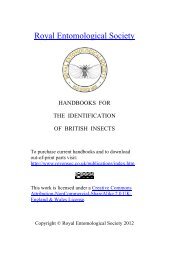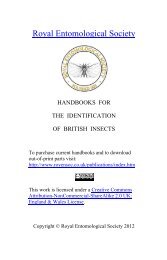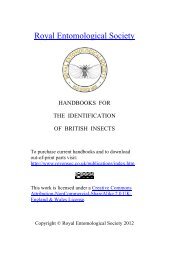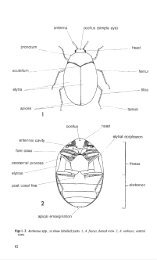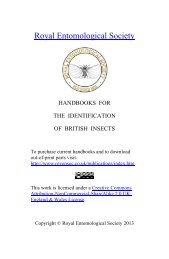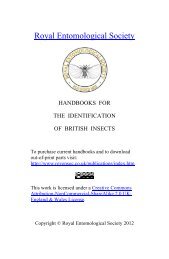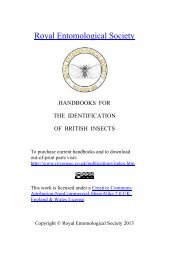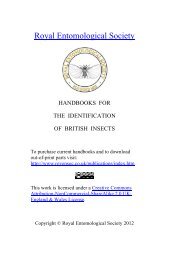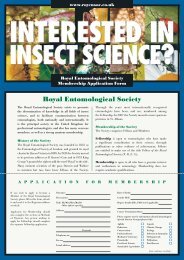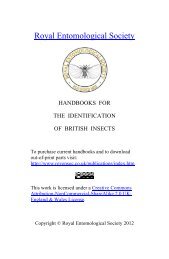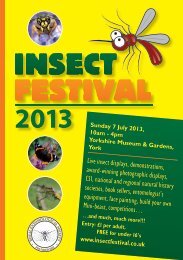Vol 5 Part 12. Coleoptera. Cerambycidae. - Royal Entomological ...
Vol 5 Part 12. Coleoptera. Cerambycidae. - Royal Entomological ...
Vol 5 Part 12. Coleoptera. Cerambycidae. - Royal Entomological ...
- No tags were found...
You also want an ePaper? Increase the reach of your titles
YUMPU automatically turns print PDFs into web optimized ePapers that Google loves.
CERAMBYCINAEllElytra with apices each produced into a pair of stout spines (fig. 17). Elytra dulland indistinctly punctured .................................................................. 11.ll Elytra with outer apical spine shorter than sutural spine. Thorax deeply transverselyrugose and finely punctured. Elytra with shining golden pubescencewhich is distributed in rather obscure patches arranged more or less in threetransverse broad bands. Antennae with each segment serrate on outer margin.Length 24-46 mm. East African species. Chiefly from Afzelia* Pachydissus hector Kolbe.Elytra with outer apical spine longer than sutural spine (fig. 17). Thorax nottransversely rugose ; coarsely punctured. Elytra with dull yellow pubescenceevenly distributed over entire surface. Antennae with each segment with ashort apical spine on inner margin. Length 20-30 mm. North American species.Chiefly in Quercus .......................................* Romaleum rufulum Haldeman.12 Head broader than thorax. First abdominal sternite elongate, as long as remainingsternites combined. Anterior coxal cavities closed behind. Thorax elongate.Elytra brownish yellow ...................................................... Obrium (p. 12).Head narrower than thorax. First abdominal sternite less elongate, shorter thanremaining sternites combined. Anterior coxal cavities open behind ............ 13.13 Legs unusually short, with hind tibiae not more than two-thirds as long as femora,which are very strongly clavate (fig. 18). Body strongly depressed. Elytratestaceous, strongly punctured. Antennae much shorter than body. Length7-10 mm. North American species. Chiefly from seasoned Quercus and Hickoria* Smodicum cucujiforme Say.Legs of normal proportions, with hind tibiae at least as long as femora. Bodynever strongly depressed ..................................................................... 14.14 Thorax distinctly elohgate. Antenna with third segment not longer than fourth.Elytra light brown. Length 4·5-6 mm. Chiefly from dead twigs and wicker·work ............................................................ ... Gracilia minuta (Fabricius).Thorax quadrate to strongly transverse. Antenna with third segment longer thanfourth ............................................................................................. 15.15 Anterior coxal cavities transverse, angulated externally (fig. 19b). Distancebetween inner margins of eyes above antennae slightly less than distance betweenbases of antennae (fig. 20). Elytra never with conspicuous yellow bands orgrey at apex .................................................................................... 16.Anterior coxal cavities rounded, not angulated externally (fig. 19a). Distancebetween inner margins of eyes above antennae slightly more than distance betweenbases of antennae. Elytra with conspicuous yellow bands or grey at apex(except Trinophylum) ........................................................................ 20.16 Anterior coxae separated by at least their combined width. Sides of thorax denselycovered with long outstanding greyish-white hairs; disc with a conspicuouspair of round black, shining tubercles (fig. 21). Length 8-20 mm. From dry,seasoned coniferous timbers, especially in attics of houses and in packing-casesHylotrupes bajulus (Linnaeus).Anterior coxae subcontiguous. Sides of thorax sparsely covered with short,usually dark hairs ; disc without black tubercles ....................................... 17.17 Sides of thorax strongly angled medially. Elytra densely covered with scarletpubescence. Length 9-ll mm .................(*) Pyrrhidium sanguinem (Linnaeus).Sides of thorax rounded. Elytra never covered with scarlet pubescence ............ 18.18 Elytra and thorax metallic blue or violet. Disc of thorax dull and very stronglyrugose. Length ll- 13 mm. From dead or seasoned coniferous timberCallidium violaceum (Linnaeus)Elytra never metallic, but if bluish, then thorax red. Disc of thorax shining andsparsely or finely punctured ............................................................... 19.19 Elytra uniformly yellow, blue or brown. Length at least 6 mm.Phymatodes (p. 12).Elytra with basal third red and the remainder black with two oblique whitestripes. Length at most 5 mm ............................ Poecilium alni (Linnaeus).20 Elytra densely pubescent, with a conspicuous pattern of contrasting colour. Eyesfinely faceted .................. ............................................. ..................... 21.Elytra very sparsely setose, brown, shining ; densely and coarsely punctured.Eyes coarsely faceted. Length 12-15 mm. Indian species, but now possiblyestablished in Britain. Chiefly from Quercus(*) Trinophylum cribratum Bates.




